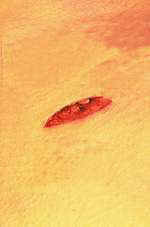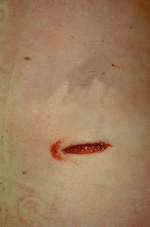
![]()
Home
![]()
Editorial
![]()
Free
Medical Advice
![]()
Patient Education
![]()
Review
![]()
Interview
![]()
Horizons
![]()
Sections
![]()
News
![]()
Events
![]()
Directory
![]()
Jokes
![]()
Links
Traumatology
Lacerations & Incised Wounds
3-Lacerations
These wounds are commonly known as 'gashes, tears or cuts' of the skin. The skin
surface is split or torn following blunt trauma, and the force causes the full thickness
of the skin to be damaged. Lacerations therefore bleed profusely.
Areas of the body that are commonly the site of lacerations are those with underlying bony
support, such as above the eyebrows, on the scalp and face, or over the knees etc, whilst
they are less common on areas of the body that are softer such as the buttocks.
Contact with motor vehicles may also cause splitting of the skin due to grinding type
movements over the surface.
Lacerations have ragged wound edges, as they have been torn apart and not neatly incised
as in a surgical wound. However, scalp lacerations sometimes resemble incised wounds when
they have been caused by a regular shaped object. If the wound is examined closely (eg
with a hand-held magnifying glass), the ragged edges can be visualised, along
with,crushing and bruising
hairs driven into the tissues tissue strands (nerves, fibrous brands, vessels) may cross
the depths of the wound
4- Incised Wounds:
Incised wounds are sharp cut-like injuries, made by knives or broken glass etc.The edges
of the wound will vary according to the nature of the cutting edge of the object, in that
a razor will leave regular margins, whereas an axe may leave the wound margins crushed and
bruised, resembling a laceration.
Slash Wounds
These are wounds where the length is greater than the depth, eg a slice wound across the
skin. If the wound involves major blood vessels, it can be life threatening, but in
general, they are not as serious as stab wounds.
5- Stab Wounds
These are wounds where the depth of injury is greater than the length. They penetrate more
deeply than slash wounds and tend to come into contact with vital organs in the chest and
abdomen.Stabbing is the most common mode of homicide in the UK, due to the strict control
of guns.Stab wounds are caused most obviously by knives, but are also caused by bayonets
and swords, as well as scissors and even blunter instruments such as screwdrivers.
These type of wounds have the following features,
They are usually slit-like, but when the object is removed the skin contracts slightly,
leaving a wound that is slightly shorter than the blade width. The centre of the wound
often widens.
Muscle and skin contracture around the wound often obscures the size of the knife blade
The size of the wound depends upon the depth of penetration of the knife, and whether, for
example the parallel section of the knife has been reached (ie near to the hilt of the
knife)
If the blade is 'rocked' in the wound (ie either the assailant moves the knife around, or
the victim moves in relation to the knife), the wound is longer than if the knife is
inserted in and out rapidly and in the same direction
Irregular or 'V' shaped wounds arise when the knife is twisted in the wound
Most knives are single edged, and have a sharp cutting surface whilst the back of the
blade is blunt. The wound may be sharp at one end, and blunt at the other. Unfortunately,
this is not always the case, as the blunt edge of the knife may split the skin, and
resemble a double edged knife wound.
Knives that have a handle guard or 'hilt' may be present around the wound if they are
forcefully stabbed into the victim The depth of the wound is often longer than the length
of the knife because of the compressibility of skin and underlying structures,
particularly in the abdominal cavity


It is important to realise that stab wounds can be made with minimal force. The important
factor is the sharpness of the tip of the blade - once it has penetrated clothing and
skin, remarkably little force is required to follow through and create a deep knife wound.
In addition, the faster the stabbing action, the easier it is to penetrate skin.
6- Defence Wounds
A victim of assault can sustain quite characteristic injuries during the course of the
assault, as they try to defend themselves, and ward off blows. When warding off knives,
the victim usually has multiple incisions across the
palmar surfaces of the hands, where attempts have been made to grab the knife blade.

